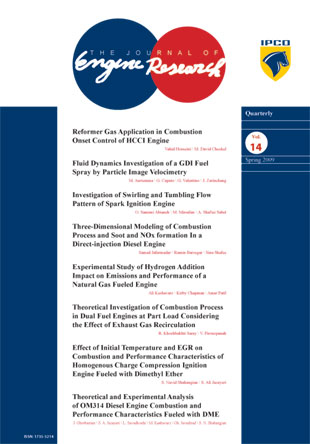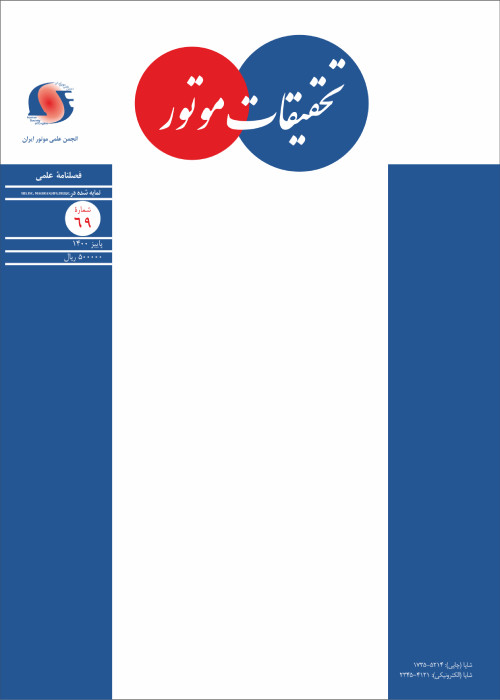فهرست مطالب

نشریه تحقیقات موتور
پیاپی 14 (بهار 1388)
- بهای روی جلد: 40,000ريال
- تاریخ انتشار: 1388/09/01
- تعداد عناوین: 8
-
-
Page 3Homogenous charge compression ignition (HCCI) combustion is defined as spontaneous multi-site combustion of a nominally premixed mixture that causes fast pressure rise and short combustion duration. To avoid excessive pressure rise rate and knocking, HCCI engines are fueled with highly diluted mixture using a combination of excess air and/or EGR. HCCI combustion is attractive due to extremely low emission output and high thermal efficiency but practical engines must overcome de-rating to a part-load power level and high HC and CO emissions. More importantly, HCCI engines lack a direct method of combustion timing control and this limits operating flexibility. One method of timing control is to adjust mixture ignitability using a fuel blending agent with differing ignition properties than the base fuel. Reformer gas (RG) is a mixture of light gases dominated by hydrogen and carbon monoxide that can be produced from base hydrocarbon fuels by several reforming techniques such as partial oxidation, autothermal or steam reforming. In a series of experimental studies, reformer gas was used to control combustion timing using a CFR engine and various base fuels: compressed natural gas (gas, high octane), iso-octane (liquid, high octane) and n-heptane (liquid, low octane). The effects of reformer gas on engine operating parameters and combustion characteristics were shown to differ for different base fuel. Keeping other influential parameters constant, increasing RG mass fraction in a natural gas mixture advanced combustion timing and shifted the operating range of the engine toward leaner mixtures. This enabled the natural gas-fueled HCCI engine to operate at leaner mixtures with decreased knock intensity and smoother combustion behavior. For iso-octane and n-heptane base fuels, combustion timing was retarded significantly as RG blend fraction increased. For the case of iso-octane the operating region did not change. However, for the n-heptane base fuel, the operating range was shifted toward richer mixtures, enabling higher indicated power and thermal efficiency. A chemical kinetic study of n-heptane / RG ignition showed that the influence of hydrogen was to suppress the first stage combustion and decrease the radical concentration after first stage combustion, thus delaying the main stage combustion, (despite faster major reaction rates during the main combustion period).Keywords: Combustion, Reformer Gas, Hydrogen Enrichment, Combustion Control, HCCI Engine
-
Page 19In this work, result of experimental investigation on interaction of fuel spray generated by a swirled type injector, with air motion in a prototype cylinder are presented. Experiments were carried out by planar imaging and particle image velocimetry (PIV) techniques in order to provide information about the spray structure evolution and instantaneous velocity distribution of air motion and fuel spray at different operating condition. The experimental setup includes an engine head and a prototype cylinder with optical access suitable to stabilize conditions of tumble flow close to the real SIDI engines. A common rail injection system was used with a swirled type injector of a nominal cone angle 50° and a nozzle diameter 0.55 mm. A blower, under steady state condition, supplies a suitable intake flow rate to simulate that one evolves in real engines at different operating conditions. Tests were carried out by setting the pressure drop between the intake manifold and cylinder of 350 mm H2O, valve lifts and 9 mm and injection pressure 10 MPa. The measurement, have been done on a plane across the cylinder and injector axis with a field of view of 47 mm in diameter. PIV of air motion shows a fluid dynamics structure clockwise rotating with homogenous structure. The velocity profiles show 30% increasing of maximum velocity at operating condition of mm with respect to mm. At the first stage of injection, results of planar imaging show a fuel spray that depicts a solid structure with a penetration axis primarily controlled by the fuel momentum at later time; the fuel spray depicts a less cone angle with respect to those obtained by analyzing the spray under air flow quiescent condition. Then, because of tumble motion, the fuel spray is distorted and disintegrated. Images show the formation of large clusters of fuel which are transferred in wide region within the cylinder. At the first stage of injection, PIV results of instantaneous velocity distribution of fuel spray show a strong exchange of momentum with air motion evolving inside the cylinder. At later time, velocity profiles of fuel droplets indicate a strong correlation with tumble motion that becomes the parameter regulating breaking, dispersion and transferring liquid fuel in the periphery cylinder.Keywords: GDI, Fluid dynamic, Fuel spray, PIV, Velocimetry
-
Page 27Gas motion within the cylinder is one of the major factors that control the combustion process in spark ignition engine. It also has significant impact on heat transfer. Both the bulk gas motion and the turbulence characteristics of the flow are important and governing the overall behavior of the flow. An arrangement for obtaining a stratified charge, using port injection, is proposed for a current design of a spark ignition engine. The behavior of combustion are simulated with Computational fluid dynamic and tested. Engine testing was performed using dynamometer for measuring the lean burn limit of the current spark ignition engine. Some concepts for premixed lean burn are introduced during the previous decade and with this state of the art concept the swirl and tumble flow pattern can generate in each speed, therefore the effect of these pattern on lean burn limit is investigated.Keywords: Swirl Flow Pattern, Tumble Flow Pattern, Lean Burn, Brake Specific Fuel Consumption, Brake Mean Effective Pressure
-
Page 35This paper is presented to study the combustion process and emissions in a direct injection diesel engine. Computations are carried out using a three-dimensional model for flows, sprays, combustion and emissions in Diesel engines. Interactions between combustion and emissions with flow field are considered and it is shown that soot mass fraction increases at regions with low turbulence intensity and fuel rich zones. Impingement of spray with the piston walls is also modeled by Wall-jet functions and is shown that soot mass fraction tends to increase at impinging zones. Also in high temperature areas where Air Fuel Ratio (AFR) nears unity and oxygen is available, NOx mass fraction will increase. Results of this model show a good agreement with the corresponding data in the literature.Keywords: Diesel Engine, Turbulence, Combustion, Spray, Emission
-
Page 43Hydrogen is seen as one of the important energy carriers of the future with potential to reduce local as well as global warming. The main by-product of the combustion of hydrogen in air is water vapor and trace quantities of oxides of nitrogen. An experiment was conducted to study the impact of hydrogen/natural gas blends on performance, thermodynamic efficiency and exhaust gas emissions in a reciprocating four stroke cycle engine. For this purpose a four-stroke, 4.2 L, V-6 naturally aspirated natural gas engine was used. This engine was coupled to an eddy current wet type dynamometer. First, the engine was tested with natural gas to develop a baseline for comparison with hydrogen/natural gas fuel blends. A test matrix was used to that included variation of engine load and air-to-fuel ratio. The engine was tested at throttle openings of 50% and 100% and equivalence ratios of 1.0 (stoichiometric) and 0.9 (lean) for hydrogen percentages of 10%, 20% and 30% by volume. The test results showed a reduction in NOx and CO for most of the cases. The engine power and torque slightly decreased when the hydrogen concentration was increased. This paper fully describes the test setup, the test matrix, and the test procedures. The results are fully analyzed and presented to illustrate the impact of hydrogen-enhanced natural gas fuel blends on engine performance and emissions.Keywords: Hydrogen, Thermodynamic Efficiency, Natural Gas Engine, Engine Performance, Emission
-
Page 51The dual fuel engines at part loads inevitably suffer from lower thermal efficiency and higher carbon monoxide and unburned fuel emission. This work is carried out to investigate combustion characteristics of a dual fuel (diesel- gas) engine at part loads, using a single zone combustion model with detailed chemical kinetics for combustion of natural gas fuel. The authors developed software in which the pilot fuel is considered as a subsidiary zone and a heat source which is deriving from two superposed Wiebe’s combustion functions to account for its contribution to ignition of gaseous fuel and the rest of total released energy. Chemical kinetics mechanism is consisted of 112 reactions with 34 species. This quasi-two zone combustion model is able to establish the development of the combustion process with time and the associated important operating parameters, such as pressure, temperature, heat release rate (H.R.R) and species concentration. Also, this model is able to calculate accumulated heat release, ignition delay and combustion duration of gaseous fuel air mixture. Therefore this paper is an attempt to investigate the combustion phenomenon at part loads and using hot exhaust gas recirculation (EGR) to improve the above mentioned drawbacks and problems. By employing this technique, it is found that, low percentages of EGR, considering its thermal and radical effects, have the positive effect on performance and emission parameters of dual fuel engines at part loads. Predicted values show good agreement with corresponding experimental values in a special engine operating condition (1/4 load, 1400 rpm). Implications will be discussed in details.Keywords: Quasi, Two Zone Combustion Model, Chemical Kinetics, Natural Gas, Dual Fuel Engines, Exhaust Gas Recirculation
-
Page 63Homogeneous Charge Compression Ignition (HCCI) combustion is a pioneer method of combustion in which pre-mixed fuel and oxidizer (typically air) are compressed to the point of auto-ignition. HCCI engines can operate with most alternative fuels, especially, dimethyl ether (DME) which has been tested as a possible diesel fuel due to its simultaneously low NOx and PM emissions. In this paper a single zone detailed chemistry combustion model for determining the time evolution of the homogenous reacting gas mixture in the combustion chamber and performance characteristics of the engine has been developed. The aim of this paper is to analyse the effect of intake temperature and EGR on the characteristics of auto-ignition and operating window of the HCCI combustion considering knock and misfire boundaries.Keywords: HCCI, DME, Emissions, Performance, EGR
-
Page 71Among the alternative diesel engine fuels, dimethyl ether (DME) attracted so much attention as an alternative fuel for the diesel engine since the properties of the DME are fitted to the diesel engine combustion. There are high expectations for DME as a new alternative fuel in heavy-duty diesel engines. This research investigates a naturally aspirated diesel engine combustion and performances characteristics while using DME. In the experimental part of the work, OM314 direct-injection diesel engine was used as a base engine. A comprehensive full cycle was coupled with a multi zone combustion model to simulate performance characteristics of the engine. Results of the volumetric efficiency show that the highest brake torque is achievable in the middle speed range. The power-speed diagram shows that brake torque in diesel mode operation is much higher than DME operation, where the engine speed is less than 1900rpm. However in engine speeds over than 1900rpm, brake torque in DME mode operation would be higher. Emissions results show that, almost zero soot is produced in DME operation and NOx emissions are also reduced up to 75 percent in comparison with diesel mode operation.Keywords: Dimethy l ether_multi zone combustion model_emissions_performance_modeling


